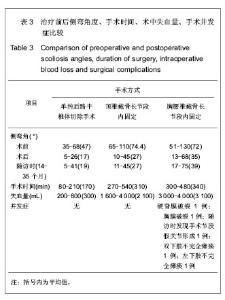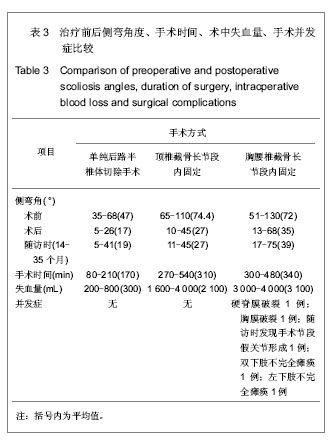| [1] Dubousset J, Zeller R, Miladi L,et al. Orthopedic treatment of spinal deformities in infancy and early childhood.Rev Chir Orthop Reparatrice Appar Mot. 2006;92(1):73-82.
[2] 张敏刚,王延宙,王恒冰,等.后路半椎体切除椎弓根器械固定治疗小儿先天性脊柱侧凸[J].临床骨科杂志,2007,10(3):193-195.
[3] Ruf M, Jensen R, Letko L,et al. Hemivertebra resection and osteotomies in congenital spine deformity.Spine (Phila Pa 1976). 2009;34(17):1791-1799.
[4] 郝定均,贺宝荣,王晓东,等.后路经椎弓根半椎体切除固定融合治疗完全分节型胸腰椎侧后凸畸形[J].中国脊柱脊髓杂志,2009, 19(3):188-192.
[5] Samdani AF, Ranade A, Sciubba DM,et al. Accuracy of free-hand placement of thoracic pedicle screws in adolescent idiopathic scoliosis: how much of a difference does surgeon experience make. Eur Spine J. 2010;19(1):91-95.
[6] Ruf M, Jensen R, Jeszenszky D,et al. Hemivertebra resection in congenital scoliosis -- early correction in young children. Z Orthop Ihre Grenzgeb. 2006;144(1):74-79.
[7] Suk SI, Lee SM, Chung ER,et al. Determination of distal fusion level with segmental pedicle screw fixation in single thoracic idiopathic scoliosis.Spine (Phila Pa 1976). 2003;28(5):484-491.
[8] Tao F, Shi Z, Xie Y, Pan F,et al. Determination of lowest instrumented vertebra by the location of apical vertebra in Lenke type 1 adolescent idiopathic scoliosis.Int Orthop. 2011;35(4):561-567.
[9] 仉建国,张新华,邱贵兴,等.特发性脊柱侧凸远端融合椎的选择[J].中华骨科杂志,2010,30(4):321-324.
[10] 王岩,张永刚,张雪松,等.后路半椎体切除、短节段经椎弓根内固定术治疗小儿先天性脊柱侧凸[J].中国脊柱脊髓杂志,2006,16(3): 196-199.
[11] 李明,倪春鸿,朱晓东,等.后路半椎体切除节段固定矫正侧后凸畸形疗效初步观察[J].中国矫形外科杂志,2004,12(5):338-341.
[12] 仉建国,邱贵兴,于斌,等.后路半椎体切除术治疗先天性脊柱侧后凸的初步结果[J].中华骨科杂志,2006,26(3):156-160.
[13] 吕国华,王冰,康意军,等.后路半椎体切除椎弓根螺钉内固定治疗小儿先天性脊柱畸形[J].中国脊柱脊髓杂志,2008,18(3): 187-189.
[14] Suk SI, Kim JH, Kim WJ,et al. Posterior vertebral column resection for severe spinal deformities.Spine (Phila Pa 1976). 2002;27(21):2374-2382.
[15] 邱勇,王斌,吴亮,等.胸腔镜下前路矫形术治疗特发性胸椎侧凸的初步临床结果[J].中华骨科杂志,2004,24(2):65-69.
[16] 李超,周宇,付青松,等.经后路胸膜外松解脊椎楔形截骨治疗重度特发性脊柱侧凸畸形[J].中国脊柱脊髓杂志,2009,19(3): 182-187.
[17] 孙保胜,孙琳,祁新禹,等.先天性脊柱侧凸合并高肩胛症的手术治疗[J].山东医药,2011,51(24):8-9. |

